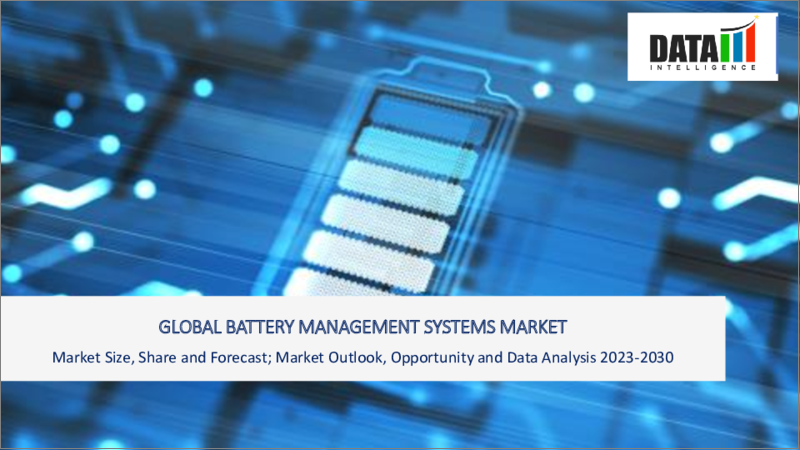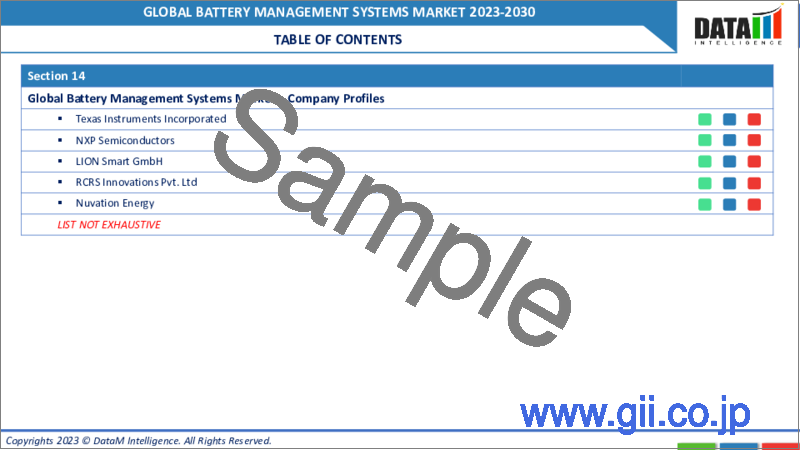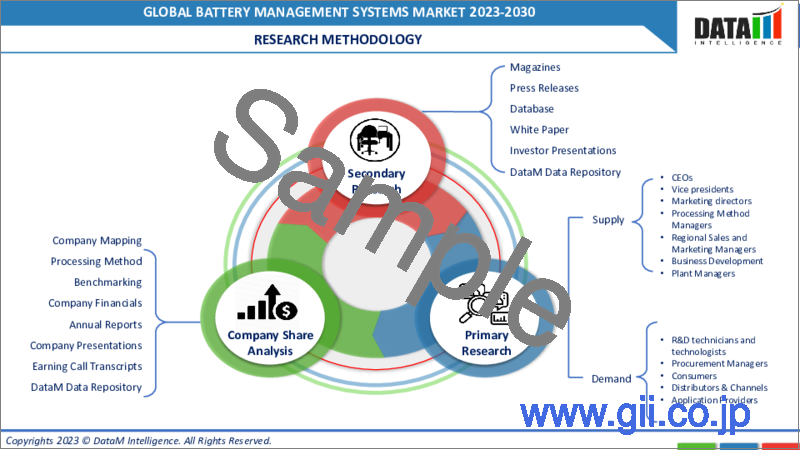|
|
市場調査レポート
商品コード
1325361
バッテリー管理システムの世界市場-2023年~2030年Global Battery Management Systems Market - 2023-2030 |
||||||
カスタマイズ可能
適宜更新あり
|
|||||||
| バッテリー管理システムの世界市場-2023年~2030年 |
|
出版日: 2023年08月04日
発行: DataM Intelligence
ページ情報: 英文 195 Pages
納期: 即日から翌営業日
|
- 全表示
- 概要
- 目次
市場概要
バッテリー管理システムの世界市場は、2022年に71億米ドルに達し、2023-2030年の予測期間中にCAGR 18.9%で成長し、2030年には284億米ドルに達すると予測されています。
バッテリー管理システムは、電気自動車、エネルギー貯蔵、家電製品など様々な分野で応用されており、これが市場の主な促進要因となっています。産業界によるバッテリー性能の向上とバッテリー効率化システムに対する需要の高まりにより、システム需要が増加しています。さらに、バッテリー管理システムは、全体的な性能バッテリーの状態を監視するエネルギー貯蔵システムの制御を持っています。
リチウムイオン電池は、他の電池に比べてエネルギー密度が高く、急速充電が可能で、寿命が長いため、市場シェアの半分以上を占めています。環境に優しいため、政府が充電式電池を導入していることも、リチウムイオン電池の市場を牽引する要因です。リチウムイオン二次電池はエネルギー密度が高く、自己放電容量が比較的小さいため、温室効果ガスの排出量が削減されます。
市場力学
再生可能セクターにおける効率的なバッテリー監視の需要拡大
再生可能エネルギー分野の成長に伴い、従来のエネルギー資源よりも温室を採用する人が増えています。必要に応じてバッテリーを適切に監視することが重要です。再生可能エネルギーを利用する消費者は、ゼロ・ネット請求からあまり恩恵を受けていないです。それでも電気料金は支払わなければならないです。
リチウムイオン電池は、再生可能エネルギー貯蔵技術の分野でリードしています。リチウムイオン電池は、低エネルギー貯蔵につながる高エネルギー貯蔵を可能にします。バッテリーを随時監視することで、バッテリーの性能を確保し、予期せぬ故障のリスクを低減します。
ハイブリッド車の販売増加
気候変動は主要な要因であり、燃料自動車による大気汚染は公害を増加させるため、人々は環境に優しい輸送サービスに移行しています。政府はハイブリッド車の販売促進に投資しています。例えば、2023年5月16日、インドのカーボンニュートラル・プロジェクトのための政府のイニシアチブを支援するために。スズキはCNGとHEVの組み合わせを含む様々なオプションを発表しています。2022年末、ハイブリッド車の販売台数は27%増加しました。スズキは2030年までに販売台数の25%をハイブリッド車が占めると予測されています。
BMSは、ハイブリッド車用バッテリーの温度、電圧、充電状態など、さまざまなパラメーターを監視・制御するシステムであるため、ハイブリッド車の販売台数の増加により、BMSの成長が見込まれています。BMSは、充電と放電のプロセスを調整することでバッテリーの性能を最適化し、バッテリーが最適な範囲内で動作するようにします。その結果、バッテリーの寿命が向上し、全体的な長寿命化が実現します。これは、ハイブリッド車のオーナーやメーカーにとって極めて重要なことです。
高コストと専門技術の必要性
バッテリー管理システムにおける大きな制約のひとつは、バッテリーの生産に必要な全体的なコストが高いことです。バッテリー管理には高価なソフトウェアが必要なため、中小企業には手が届きにくいです。また、使用される技術には複雑な調査が必要で、その結果、投資額が高くなります。
さらに、バッテリー管理システムで働くには、強力な技術的専門知識が必要です。バッテリー管理システムの専門知識がなければ、バッテリー管理システムの成長に影響を与えることになります。バッテリー管理システムには、システムの適切な機能を監視するための十分な時間と労力が必要であり、これが市場の成長を妨げます。
COVID-19影響分析
パンデミックは、より高い金利のローンや株式投資家へのリターンなど、バッテリー管理プロジェクトのコスト増につながっています。COVIDはバッテリー管理市場に影響を与え、バッテリーの価格が上昇します。経済的混乱はエネルギー貯蔵プロジェクトへの投資の減少につながります。
エネルギー生産コストの上昇と融資の厳格化により、初期段階にあるプロジェクトは保留されます。多くの企業は、財政状況下でプロジェクトに投資することが難しく、それがプロジェクトの遅れにつながっています。バッテリー管理システムの生産で最大の市場を持つ中国は、中国に依存している企業が大きな損失を被るため、より大きな影響を及ぼします。
ロシア・ウクライナ影響分析
ロシアとウクライナの戦争により、バッテリー製造のための資源供給が影響を受けています。重要な鉱物やリチウムのような資源は、地政学的緊張のために混乱に直面しています。これらの資源の不足は、価格の変動や遅れにつながります。紛争のため、この地域の政府は貿易制限を課しました。
ロシアとウクライナはエネルギー資源のほとんどを生産しているため、紛争による混乱がサプライチェーンに影響を与えています。リチウムは、EVの生産に使用されるリチウムイオン電池の最も需要な成分でもあります。地政学的な問題により、投資家は投資を控えています。
AI(人工知能)の影響分析
AIアルゴリズムは、EV充電インフラのデータ駆動型意思決定に利用できます。バッテリーからの大量のデータを分析します。この価値は利害関係者に貴重な洞察を提供します。この情報は、バッテリー管理システムの展開を最適化するために非常に有用です。
機械学習アルゴリズムの助けを借りて、バッテリーの充電や放電など、バッテリーの電力容量を検出することができます。過去のデータから、AIは将来必要とされるエネルギー需要を分析することができます。AIはサイバー脅威を検出し、バッテリー管理システムを保護し、データの完全性と機密性を確保することができます。
目次
第1章 調査手法と調査範囲
第2章 定義と概要
第3章 エグゼクティブサマリー
第4章 市場力学
- 影響要因
- 促進要因
- 再生可能セクターにおける効率的なバッテリー監視の需要拡大
- ハイブリッド車の販売増加
- 抑制要因
- 規制の欠如
- 高コストと専門技術の必要性
- 機会
- 影響分析
- 促進要因
第5章 産業分析
- ポーターのファイブフォース分析
- サプライチェーン分析
- 価格分析
- 規制分析
第6章 COVID-19分析
第7章 タイプ別
- 可搬型電池
- 定置型電池
第8章 電池タイプ別
- リチウムイオン
- 鉛蓄電池
- ニッケル系
- 固体
- フロー電池
第9章 用途別
- 自動車用
- 産業用
- 再生可能エネルギー
- 通信
- 軍事・防衛
第10章 地域別
- 北米
- 米国
- カナダ
- メキシコ
- 欧州
- ドイツ
- 英国
- フランス
- イタリア
- スペイン
- その他欧州
- 南米
- ブラジル
- アルゼンチン
- その他南米
- アジア太平洋
- 中国
- インド
- 日本
- オーストラリア
- その他アジア太平洋
- 中東・アフリカ
第11章 競合情勢
- 競合シナリオ
- 市況/シェア分析
- M&A分析
第12章 企業プロファイル
- Leclanche
- 会社概要
- 製品ポートフォリオと説明
- 財務概要
- 主な動向
- Lithium Balance
- Hydrogenic Corporation
- Eberspaecher Vectures
- Storage Battery System.
- Johnson Matthey
- Linear Technology Corporation
- BMS Powersafe.
- Texas Instruments
- NXP Semiconductors NV
第13章 付録
Market Overview
Global Battery Management Systems Market reached US$ 7.1 billion in 2022 and is expected to reach US$ 28.4 billion by 2030 growing with a CAGR of 18.9% during the forecast period 2023-2030.
Battery management system offers application in various sectors such as electric vehicles, energy storage, and consumer electronics which is a major driver for the market. The system demand has increased due to the rising demand for enhanced battery performance and battery efficiency systems by the industries. Furthermore, the battery management system has control of the energy storage system which monitors the overall performance battery status.
The lithium-ion battery has higher energy density, fast charging capacity, and longer life compared to other batteries which made to contribute more than half of the share in the market. Governments implementing rechargeable batteries as they are environmentally friendly is another market driving factor for lithium-ion batteries. The battery has a longer energy density and relatively low self-discharge capacity with reduced greenhouse gas emissions.
Market Dynamics
Growing Demand for Efficient Battery Monitoring in the Renewable Sector
With the growth in the renewable sector, more people adopting greenhouses rather than traditional energy resources. It is important to ensure proper monitoring of batteries when required. A consumer using renewable energy doesn't get much benefitted from zero net billings. Still, they have to pay electricity bills.
Lithium-ion batteries lead in the sector of renewable energy storage technology. In which they allow high energy storage which leads to low energy storage. By monitoring batteries time to time to ensure the performance of the battery which leads to have lower risk of unexpected failures.
Increasing Sales of Hybrid Vehicles
Climate change which is a major factor and air pollution caused by fuel vehicles increases pollution so people moving towards green transportation services. The government is investing in boosting the sales of hybrid vehicles. For instance, on 16 May 2023, to support government initiatives for India's carbon neutrality project. Suzuki Motor announces a variety of options which include a combination of CNG and HEV. At the end of 2022, the sales of hybrid vehicles increases by 27%. Suzuki Motors predicted that 25% of sales would come from hybrid vehicles by 2030.
The growing sales of hybrid vehicles have created growth prospects for the BMS as the system monitors and controls various parameters of the hybrid vehicle battery, including temperature, voltage, and state of charge. They help optimize the battery's performance by regulating charging and discharging processes, ensuring that the battery operates within its optimal range. This results in improved battery life and overall longevity, which is crucial for hybrid vehicle owners and manufacturers.
High Cost and Requirement of Technical Expertise
One major restrain in the battery management systems is the overall cost required for the production of batteries is high. Battery management requires software that is higher in price which makes them less affordable for small businesses. It requires complex research for the technology used which results in higher investments.
Furthermore, working in a battery management system it requires strong technical expertise. Without domain knowledge in battery management systems, it leads to the impact growth of battery management systems. For battery management systems it requires an ample amount of time and effort for monitoring the proper functions of the system which hurdles market growth.
COVID-19 Impact Analysis
The pandemic led to increased costs of battery management projects including higher interest loans and returns for equity investors. COVID affects the battery management market due to which the price of batteries increases. The economic disturbance leads to decrease investment in energy storage projects.
Due to the increase in the cost of production of energy and stricter loans, the projects which are in their early stages are put on hold. Many organizations find it difficult to invest in projects under financial situations which leads to delays in projects. China which has the largest market for the production of battery management systems affects more due to which companies which rely on China phase heavy losses.
Russia-Ukraine Impact Analysis
Due to the Russia-Ukraine war, the supply of resources for manufacturing batteries got equipment is affected. Resources like critical minerals, and lithium face disruptions due to geopolitical tensions. Shortage of these resources results in fluctuating prices and delays. Due to conflict government in this region imposed trade restrictions.
Since Russia and Ukraine produce most of the energy resources so there are disturbances due to the conflict which affect their supply chains. Lithium is also the most demanding component of lithium-ion batteries which were used in the production of EVs. Investors step back with their investments due to geopolitical issues.
AI (Artificial Intelligence) Impact Analysis
AI algorithms can be used in data-driven decision-making for EV charging infrastructures. It analyzes large volumes of data from batteries. This value provides valuable insights to stakeholders. This information is very useful for optimizing the deployment of the battery management system.
With the help of a machine learning algorithm, it can detect the power capacity of batteries such as charging and discharging of batteries. With historical data, AI can analyze the demand for energy required in the future. AI can detect cyber threats and protects battery management system and also ensure the integrity and confidentiality of data.
Segment Analysis
The global battery management system is segmented based on type, battery type, application and region.
Rising Demand for Motive Batteries in Various Industries Such as Automotive, Construction, and Agriculture
The motive battery has higher growth compared with the stationary battery. Due to its increasing demand in various industries such as automotive, construction, and agriculture. It provides high output power for machines and tools. It also monitors the battery state during peak performance. The motive battery segment provides a feature to monitor their batteries from anywhere.
For instance, on 22 May 2023, EnerSys provides solutions for industrial applications, manufacturers, and motive power batteries. The usage of motive power batteries in forklift trucks and other electric power vehicles. The motive power battery has advanced safety features that monitor battery shutdown, and temperature. Motive battery launched in 2021 with affordable battery power around the world.
Geographical Analysis
Asia-Pacific's Increasing Electric Vehicle Adoption and Government Initiatives
With the growth in population and increasing urbanization in Asian countries which includes China, India, and Japan, the government in these countries taking initiatives toward the adoption of electric vehicles. As the demand increases for sustainable transportation people adopting electric vehicles instead of fuel vehicles. Increasing demand for electric vehicles leads positive impact on the environment by reducing low carbon emissions.
The government in this region implemented many policies for the growth and development of battery management systems. Policies such as tax subsidies and incentives for each purchase of electric vehicles. For instance, on 2 Aug 2021, a new energy management system technology was launched named as BMSer. BMSer technology develops and provides energy management technologies.
Competitive Landscape
The major global players in the market include Leclanche, Lithium Balance, Hydrogenic Corporation, Eberspaecher Vectures, Storage Battery System, Johnson Matthey, Linear Technology Corporation, BMS Powersafe., Texas Instruments, NXP Semiconductors NV.
Why Purchase the Report?
- To visualize the global battery management systems market segmentation based on type, battery type, application and regions, as well as understand key commercial assets and players.
- Identify commercial opportunities by analyzing trends and co-development.
- Excel data sheet with numerous data points of battery management systems market-level with all segments.
- PDF report consists of a comprehensive analysis after exhaustive qualitative interviews and an in-depth study.
- Product mapping available as Excel consisting of key products of all the major players.
The global battery management systems market report would provide approximately 57 tables, 60 figures, and 195 Pages.
Target Audience 2023
- Manufacturers/ Buyers
- Industry Investors/Investment Bankers
- Research Professionals
- Emerging Companies
Table of Contents
1. Methodology and Scope
- 1.1. Research Methodology
- 1.2. Research Objective and Scope of the Report
2. Definition and Overview
3. Executive Summary
- 3.1. Snippet by Type
- 3.2. Snippet by Battery Type
- 3.3. Snippet by Application
- 3.4. Snippet by Region
4. Dynamics
- 4.1. Impacting Factors
- 4.1.1. Drivers
- 4.1.1.1. Growing Demand for Efficient Battery Monitoring in the Renewable Sector
- 4.1.1.2. Increasing Sales of Hybrid Vehicles
- 4.1.2. Restraints
- 4.1.2.1. Lack of Regulation
- 4.1.2.2. High Cost and Requirement of Technical Expertise
- 4.1.3. Opportunity
- 4.1.4. Impact Analysis
- 4.1.1. Drivers
5. Industry Analysis
- 5.1. Porter's Five Force Analysis
- 5.2. Supply Chain Analysis
- 5.3. Pricing Analysis
- 5.4. Regulatory Analysis
6. COVID-19 Analysis
- 6.1. Analysis of COVID-19
- 6.1.1. Scenario Before COVID
- 6.1.2. Scenario During COVID
- 6.1.3. Scenario Post COVID
- 6.2. Pricing Dynamics Amid COVID-19
- 6.3. Demand-Supply Spectrum
- 6.4. Government Initiatives Related to the Market During the Pandemic
- 6.5. Manufacturers' Strategic Initiatives
- 6.6. Conclusion
7. By Type
- 7.1. Introduction
- 7.1.1. Market Size Analysis and Y-o-Y Growth Analysis (%), By Type
- 7.1.2. Market Attractiveness Index, By Type
- 7.2. Motive Battery*
- 7.2.1. Introduction
- 7.2.2. Market Size Analysis and Y-o-Y Growth Analysis (%)
- 7.3. Stationary Battery
8. By Battery Type
- 8.1. Introduction
- 8.1.1. Market Size Analysis and Y-o-Y Growth Analysis (%), By Battery Type
- 8.1.2. Market Attractiveness Index, By Battery Type
- 8.2. Lithium-ion*
- 8.2.1. Introduction
- 8.2.2. Market Size Analysis and Y-o-Y Growth Analysis (%)
- 8.3. Lead-acid
- 8.4. Nickel-based
- 8.5. Solid-state
- 8.6. Flow battery
9. By Application
- 9.1. Introduction
- 9.1.1. Market Size Analysis and Y-o-Y Growth Analysis (%), By Application Market Attractiveness Index, By Application
- 9.2. Automotive*
- 9.2.1. Introduction
- 9.2.2. Market Size Analysis and Y-o-Y Growth Analysis (%)
- 9.3. Industrial
- 9.4. Renewable energy
- 9.5. Telecommunication
- 9.6. Military and Defence
10. By Region
- 10.1. Introduction
- 10.1.1. Market Size Analysis and Y-o-Y Growth Analysis (%), By Region
- 10.1.2. Market Attractiveness Index, By Region
- 10.2. North America
- 10.2.1. Introduction
- 10.2.2. Key Region-Specific Dynamics
- 10.2.3. Market Size Analysis, and Y-o-Y Growth Analysis (%), By Type
- 10.2.4. Market Size Analysis, and Y-o-Y Growth Analysis (%), By Battery Type
- 10.2.5. Market Size Analysis, and Y-o-Y Growth Analysis (%), By Application
- 10.2.6. Market Size Analysis, and Y-o-Y Growth Analysis (%), By Country
- 10.2.6.1. U.S.
- 10.2.6.2. Canada
- 10.2.6.3. Mexico
- 10.3. Europe
- 10.3.1. Introduction
- 10.3.2. Key Region-Specific Dynamics
- 10.3.3. Market Size Analysis, and Y-o-Y Growth Analysis (%), By Type
- 10.3.4. Market Size Analysis, and Y-o-Y Growth Analysis (%), By Battery Type
- 10.3.5. Market Size Analysis, and Y-o-Y Growth Analysis (%), By Application
- 10.3.6. Market Size Analysis, and Y-o-Y Growth Analysis (%), By Country
- 10.3.6.1. Germany
- 10.3.6.2. UK
- 10.3.6.3. France
- 10.3.6.4. Italy
- 10.3.6.5. Spain
- 10.3.6.6. Rest of Europe
- 10.4. South America
- 10.4.1. Introduction
- 10.4.2. Key Region-Specific Dynamics
- 10.4.3. Market Size Analysis, and Y-o-Y Growth Analysis (%), By Type
- 10.4.4. Market Size Analysis, and Y-o-Y Growth Analysis (%), By Battery Type
- 10.4.5. Market Size Analysis, and Y-o-Y Growth Analysis (%), By Application
- 10.4.6. Market Size Analysis, and Y-o-Y Growth Analysis (%), By Country
- 10.4.6.1. Brazil
- 10.4.6.2. Argentina
- 10.4.6.3. Rest of South America
- 10.5. Asia-Pacific
- 10.5.1. Introduction
- 10.5.2. Key Region-Specific Dynamics
- 10.5.3. Market Size Analysis, and Y-o-Y Growth Analysis (%), By Type
- 10.5.4. Market Size Analysis, and Y-o-Y Growth Analysis (%), By Battery Type
- 10.5.5. Market Size Analysis, and Y-o-Y Growth Analysis (%), By Application
- 10.5.6. Market Size Analysis, and Y-o-Y Growth Analysis (%), By Country
- 10.5.6.1. China
- 10.5.6.2. India
- 10.5.6.3. Japan
- 10.5.6.4. Australia
- 10.5.6.5. Rest of Asia-Pacific
- 10.6. Middle East and Africa
- 10.6.1. Introduction
- 10.6.2. Key Region-Specific Dynamics
- 10.6.3. Market Size Analysis, and Y-o-Y Growth Analysis (%), By Type
- 10.6.4. Market Size Analysis, and Y-o-Y Growth Analysis (%), By Battery Type
- 10.6.5. Market Size Analysis, and Y-o-Y Growth Analysis (%), By Application
11. Competitive Landscape
- 11.1. Competitive Scenario
- 11.2. Market Positioning/Share Analysis
- 11.3. Mergers and Acquisitions Analysis
12. Company Profiles
- 12.1. Leclanche*
- 12.1.1. Company Overview
- 12.1.2. Product Portfolio and Description
- 12.1.3. Financial Overview
- 12.1.4. Key Developments
- 12.2. Lithium Balance
- 12.3. Hydrogenic Corporation
- 12.4. Eberspaecher Vectures
- 12.5. Storage Battery System.
- 12.6. Johnson Matthey
- 12.7. Linear Technology Corporation
- 12.8. BMS Powersafe.
- 12.9. Texas Instruments
- 12.10. NXP Semiconductors NV
LIST NOT EXHAUSTIVE
13. Appendix
- 13.1. About Us and Services
- 13.2. Contact Us






